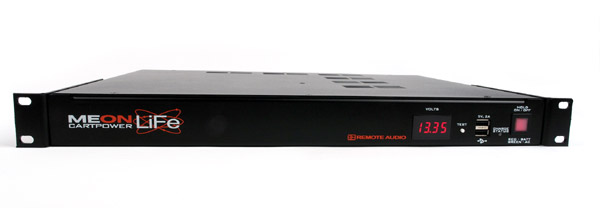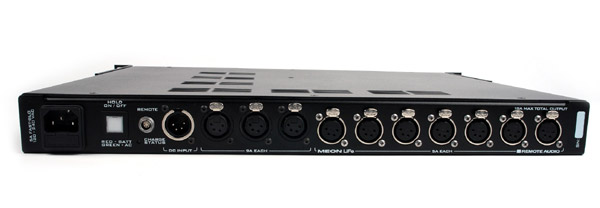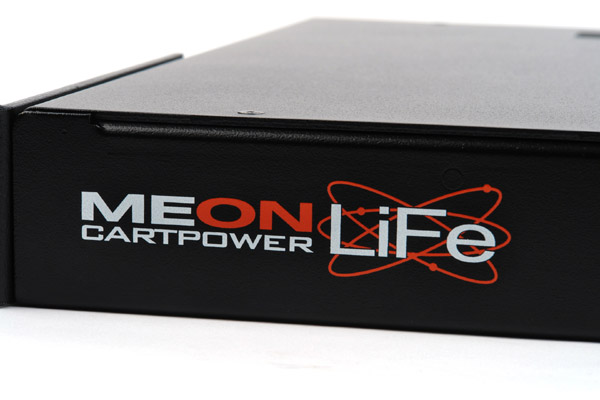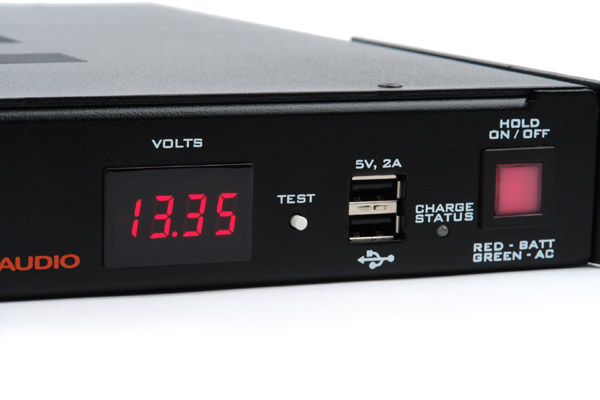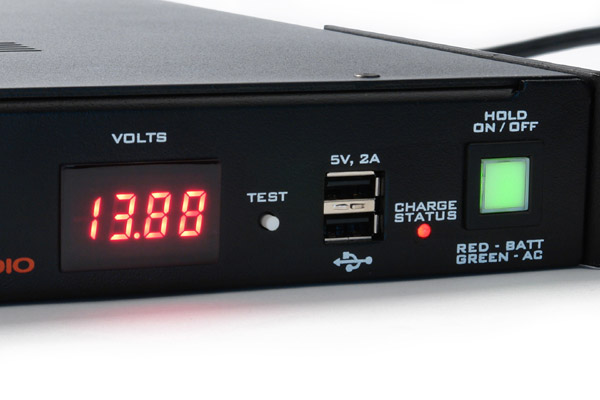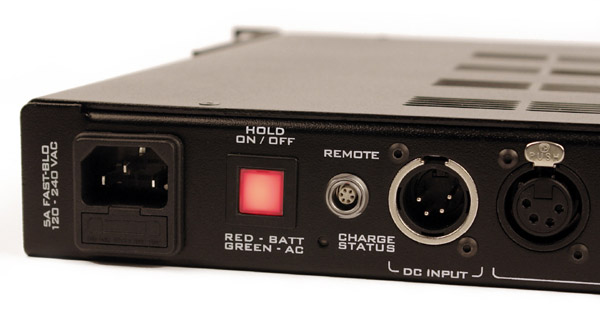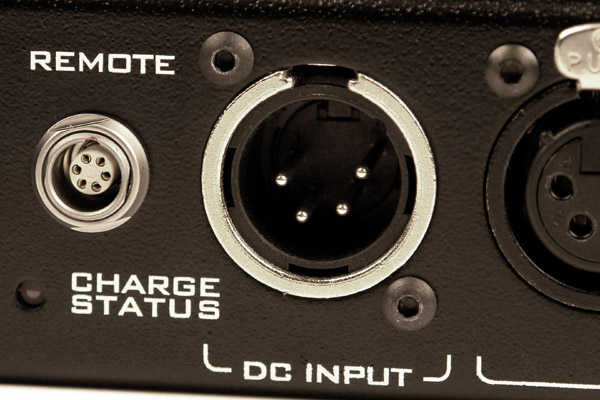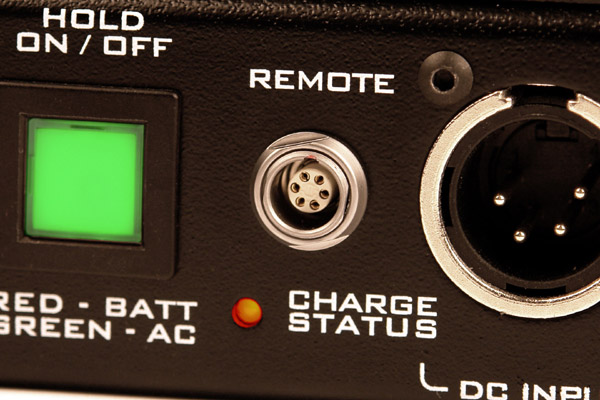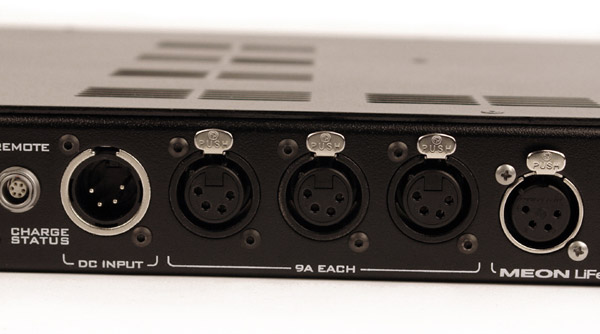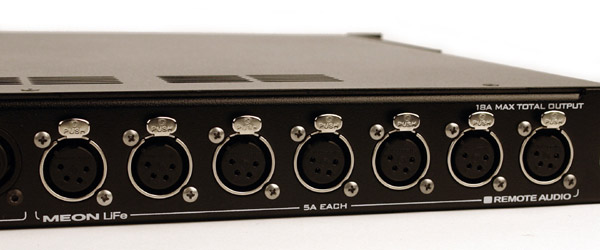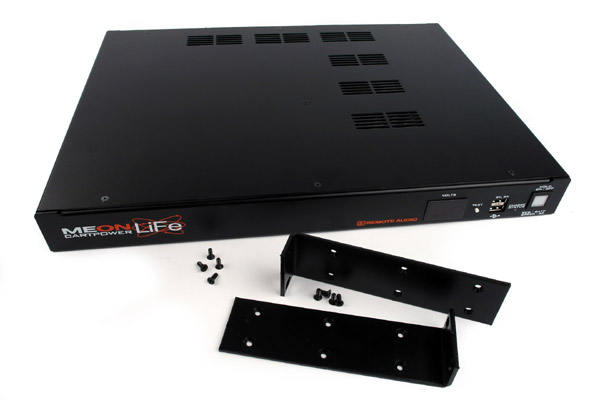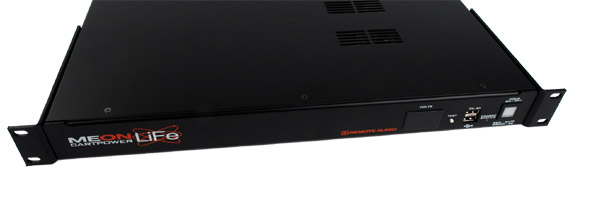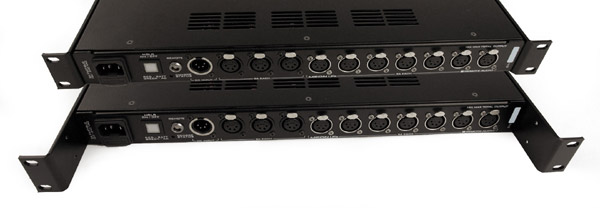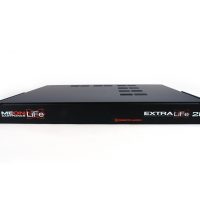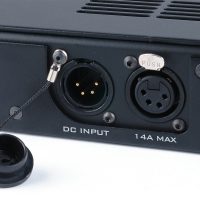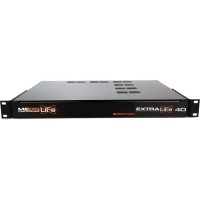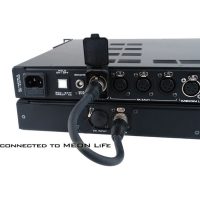Remote Audio MEON LiFe Cart Power System
1,950.00 USD CAD
Please be aware that US Federal regulations qualify certain lithium batteries as “Hazardous Materials”. This qualification carries with it an additional fee of $75 if said items are transported via aircraft. Additional fees for these items are also assessed if shipping internationally. This is a flat fee and will only apply once for shipments containing a qualifying item.
If shipping within the US you may avoid this fee by selecting standard ground shipping. Otherwise we will contact you with a final shipping quote upon receiving your order.
Description
The Remote Audio MEON LiFe™ combines the basic design of the MEON v2 with the light-weight and compact size of modern Lithium-Iron-Phosphate (LiFePO4) battery chemistry at a lower price.
The Remote Audio MEON LiFe™ is a single-rackspace, self-contained power system that silently provides up to 18 Amps of 12 Volt DC and 20 Amp-hours of internal Lithium-Iron-Phosphate battery backup to ten standard 4-pin outlets in a module weighing less than 13 pounds. The chassis is constructed of durable and lightweight powder-coated aluminum, and its removable mounting ears can be reversed to allow mounting in a variety of configurations. The MEON LiFe includes an illuminated voltmeter and connects to Remote Audio’s RM or RS accessories which enable remote ON/OFF capability and/or battery monitoring. Two integral USB output jacks located on the front panel will charge or power standard 5VDC USB devices.
The MEON LiFe’s illuminated single-button ON/OFF system activates when a user engages it for approximately 2 seconds. This required hold-time helps prevent accidental power up or down of the system. When the unit receives 90VAC-264VAC power, the power button LED glows GREEN and current is provided by a low-noise AC-DC power supply rated to 18A. Simultaneously the internal battery is taken out of circuit and charged via its own dedicated internal charger capable of providing 5A of charging current. When AC power is unavailable or interrupted, the battery seamlessly takes over and the power button LED glows RED. When AC power is restored, the AC-DC power supply takes over again, the battery resumes charging, and the power button glows GREEN. Thus, the color of the LED button informs you of the origin of power to the MEON at all times. The indicator button is mirrored on the front and back of the unit for visibility regardless of the unit’s position.
Features
- All-in-one, rack mountable power system
- Single rack unit saves valuable cart space
- Under 13 pounds; minimizes overall cart weight
- Contains Lithium-Iron-Phosphate (LiFePO4) battery
- Complete recharge in 3 hours or less
- 20 Amp-hours
- 18 Amps of 12VDC when plugged into 110VAC – 240VAC mains
- Power ON/OFF mirrored from front for reverse-mount applications
- Convection cooling = no fan noise
- LED volt meter
- Test button shows battery voltage when MEON LiFe is powered off
- Remote port connects to RM (Remote Meter) and RS (Remote Switch)
- DC input for external Lead Acid battery or “EXTRA LiFe” battery modules (20Ah / 40Ah )
Internal LiFePO4 Battery
Lithium-Iron-Phosphate batteries are a relatively new technology and share common
properties with all Li-Ion technologies like lower weight and smaller size than equivalent capacities in other chemistries (such as Lead Acid and NiMH). However, a key advantage of LiFePO4 when compared to other Li-Ion types is its superior thermal and chemical stability. LiFePO4 cells are virtually incombustible (even when mishandled during charge/discharge), and they can handle much higher temperatures without degrading in performance. LiFePO4 also offers a longer calendar life and higher peak-power rating than other Li-Ion designs, and it contains no toxic heavy metals.
The MEON LiFe’s internal battery is polyfuse-protected for a maximum output of 14A, and is protected from over-charge and over-discharge conditions.*
Output Connectors
There are ten DC power outlets on the back of the MEON LiFe™ each wired in the standard 4-pin XLR configuration of PIN 4 +, PIN 1 -. Each outlet has auto-resetting breakers to protect against overload. Three of the outlets are heavy-duty connectors each capable of supplying 9A. The remaining seven output connectors are rated for 5A each. A master 18A breaker protects against combined overload when multiple outlets are used. An entire sound cart (drawing 9A or less) can be powered through a single XLR outlet if desired. For example, if power distribution to the devices on a cart is done through a Remote Audio BDS or HOT BOXv2, a single 9A XLR outlet on the MEON LiFe can power multiple devices. Alternatively, each device being powered can be cabled directly to the MEON LiFe’s ten outlets.
The MEON LiFe™ is programmed to shut down when the output voltage reaches approximately 10V as indicated on the front display. This is to prevent over-discharge of external supplemental Lead Acid batteries that may not have their own built-in protection.
USB Connectors
Two USB connectors are available on the front of the MEON LiFe™ to charge or power 5VDC USB devices (such as smartphones, digital transcription recorders, etc). The two ports have a total combined capacity of 2A @ 5V (10W) and are regulated and protected from short circuits. These USB jacks are configured in such a way to charge Apple devices at the fastest rate (highest current) available. For example, an Apple iPad will draw approximately 2A peak from one USB port. Smaller Apple devices, such as iPhones will draw approximately 1A. Thus, it may not be possible to charge an iPhone and and iPad simultaneously due to the 2A current limit from the MEON LiFe’s USB ports.
Supplemental Batteries and Charging
A supplemental battery can be used to extend runtime when AC is unavailable. An input connector (4-pin XLR Male) is provided on the back panel for connecting an external Lead Acid battery or to the MEON LiFe’s supplemental “EXTRA LiFePO4” battery modules(available in 20Ah and 40Ah versions). The XLR is wired in the configuration of PIN 1&2 -, PIN 3&4 +. (To improve reliability and reduce voltage drop, the contacts are doubled.) The XLR connector is wired in parallel with the internal LiFePO4 battery, and thus is connected to the internal charger when AC is present. The internal charger is a “smart charger,” and will not over-charge a Lead Acid battery. Note: Adding a supplemental battery in this fashion will increase the necessary overall charge time of the system.
The indicator labeled “Charge Status” verifies that charging is taking place at either the full rate (red) or topping rate (green). A fully discharged MEON LiFe will recharge fully in approximately 3 hours. The MEON’s charge/discharge controller circuitry allows it to remain connected to AC power indefinitely without fear of overcharging.
Voltage Meter and Battery Testing
The Remote Audio MEON LiFe™ includes an illuminated voltmeter on the front panel which indicates the voltage at the output connectors when the MEON LiFe is turned ON. The meter is calibrated at the factory for accuracy. However, there may be some temporary drift in readings based on ambient and internal temperature (typically less than 5%). Additionally, if an RM is connected for remote metering, there may be slight differences (less than 10mV) between the MEON LiFe and the RM voltage readings, depending on the load present at the output connectors.
When the MEON is turned OFF, pushing the TEST button on the front panel will show the voltage of the battery on the display panel. If AC is present, TEST will show the voltage of the internal battery charger. If AC is not present, TEST shows the voltage of the battery itself (including any connected supplemental batteries). This is a handy way to check the status of your batteries without having to power on the entire cart.
Connecting the RM/RS
The Remote Audio MEON LiFe™ can be used in conjunction with Remote Audio’s RM (Remote Meter) or RS (Remote Switch). The RM allows remote monitoring of voltage and current (Amps), as well as remote ON/OFF control of the MEON LiFe. The RS provides remote ON/OFF control and a low voltage indicator. Connect either device’s 6-pin connector via the “Remote” port on the rear of the MEON LiFe. See the RM and RS user guides for more details.
Noise and Shared Power Systems
It is possible to have unwanted audible noise induced into audio systems by a common (shared) power source. To optimize your system, it is recommended to use line level signals instead of mic level signals whenever practical. Also, turn phantom voltage off of all preamp inputs that are connected to non-microphone devices. If noise is still heard, unplug one device at a time from the MEON, noticing any change in noise associated with the removal of each device. If the noise goes away after unplugging a particular device, try powering that device with a separate battery. If using a separate battery causes the noise to go away, then the problem is a ground loop associated with the combination of a common power source and audio grounding schemes. Be aware that this noise will not be removed with “LC” filters found in some cart power supplies.
To remove the noise, here are a few options for interrupting the ground loop:
- Use a separate battery for the offending device.
- Try different grounding/floating schemes with the audio cables.
- In devices that use a single 9V battery, use an isolating 9V battery eliminator
such as those made by Lectrosonics. - Use a power isolator cable such as the Remote Audio Juicer cable.
Does the MEON LiFe™ use fans?
No. The MEON LiFe was designed to use convection cooling since it’s primary function is powering sound recording equipment on sets. Even the slightest hum of cooling fans cannot be tolerated on a very quiet sound stage.
When using AC power, it is best to mount the MEON LiFe™ with some free space above the chassis to allow proper cooling. The MEON LiFe™ has vent slots in the sides of it’s chassis which must remain unrestricted during operation to further facilitate cooling.
*Important Information about Internal Battery Protection In addition to the resettable circuit breakers on each output, the MEON LiFe’s battery is internally protected from overload and short circuits. In some cases, a sudden dead short at an output may activate the protection circuit of the internal battery. In this condition, the MEON LiFe will not come back on until external power is applied, either by plugging into AC or, if AC is not available, by applying a charged 12V battery to the external battery input.
Specifications
| Dimensions: | 19.00″ x 13.00″ x 1.75″ (1 Rack Space) |
| Weight: | 12.6 lbs |
| AC Input Voltage: | 90 – 264VAC, 50-60Hz |
| DC Input Voltage: | 12V Nominal Lead Acid or LiFePO4 |
| DC Output Voltage: | 12V Nominal, shutdown below 10V |
| Output Current: | 18A Max Total (AC), 14A Max Total (Internal Batt.)* |
| Output Connectors: | 3x Neutrik 4-Pin XLR Female, rated at 9A each 7x Neutrik 4-Pin XLR Female, rated at 5A each |
| Battery Capcity: | 20 Ah (40Ah and 60Ah with optional EXTRA battery modules) |
| Battery Charge Time: | ~3 hours (more with supplemental battery connected) |
| Power Switch: | Front and Rear mounted Green = AC connected, Red = AC disconnected 2 second Delay ON/OFF |
| USB Ports: | x 2, Max Combined Total of 2A @ 5V (10W) |
*14A with MEON LiFe alone; 18A with optional “EXTRA LiFe” battery module.
Download the Remote Audio MEON LiFe User Guide (981KB PDF)
Related Products
-
Remote Audio MEON Extra LiFe™ 20 Battery Module
1,050.00 USD CAD[modal title="HAZARDOUS MATERIALS NOTICE" button_text_opener="SPECIAL SHIPPING NOTICE" opener="button" button_style="alternative" ]Please be aware that US Federal regulations qualify certain lithium batteries as "Hazardous Materials". This qualification carries with it an additional fee of $75 if said items are transported via aircraft. Additional fees for these items are also assessed if shipping internationally. This is a flat…
-
Remote Audio MEON Extra LiFe™ 40 Battery Module
1,650.00 USD CAD[modal title="HAZARDOUS MATERIALS NOTICE" button_text_opener="SPECIAL SHIPPING NOTICE" opener="button" button_style="alternative" ]Please be aware that US Federal regulations qualify certain lithium batteries as "Hazardous Materials". This qualification carries with it an additional fee of $75 if said items are transported via aircraft. Additional fees for these items are also assessed if shipping internationally. This is a flat…
Product Categories
- Bags & Harnesses
- Bargain Bin
- Books
- Boom Poles
- Cables & Adapters
- Camera Interfaces
- Case
- Cases
- Cases, Bags & Harnesses
- Clearance
- Communications
- Connectors
- Deal Center
- DSLR Audio Solutions
- Expendables
- Featured
- Headphones
- Holiday Clearance
- In-Ear-Monitors
- Interfaces
- Microphones & Accessories
- Mixers
- Motorola
- NAGRA
- Podcast
- Power Solutions
- PPE
- Press Boxes
- Pro Audio Converters
- Pro Video
- Recorders
- Slates & Timecode
- Sound Carts
- Straps & Cases
- Trew Merchandise
- Uncategorized
- Used
- Walkie-Talkies
- Wireless


 US
US  Canada
Canada 